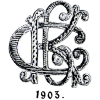A Consice History
1903-2023
The Founding of the Circle of Serbian Sisters touches upon the past and a rich history, which actually began in the first years of this past century, 1903.
Serbia Proper had won its liberty from the Turks and lived freely in its kingdom under the democratic rule of King Peter I Karadjordjevich and a most democratic president Nikola Pasic, who was at the helm. In the north, Srem, Banat, Backa and Baranja were still under the Austro-Hungarian Empire. In the south, Old Serbia and Macedonia were still under the Turks. None of these ruling powers wanted to see a free and united Serbia.
People living in the south were going through big and difficult political turmoils. First, the Albanians got together in the uprising against the Turks. While this rebellion was going on, the Bulgarian underground movements' purpose was to join this region with the Bulgarian state, brought to St. Elijah's Uprising (Ilindanski Ustanak) on July 20, 1903. Now the Albanians joined the Turks in their effort to crush this resistance. They burned more than 150 Serbian villages, looting and massacring the Serbian population everywhere. Serbs were not only put in prison but were expelled from their country to Asia Minor, tortured, even hanged. Thousands of women and children fled into the mountains to save their lives. They lived there in hiding, unprotected, with no food and without clothing. Help they needed badly, but where would it come from?
This distressing fate and suffering of the Serbian people prompted two prominent Serbian ladies from Belgrade to come to the conclusion that something had to be done for those troubled people, that Serbia was obliged to give a helping and supportive hand to Serbs there. The younger lady was Mrs. Delfa Ivanich, whose husband Ivan was at the time the secretary of consular department at the Ministry of Foreign Affairs. The older one was Miss Nadezda Petrovich, a recognized and acclaimed artist-painter from a well-known Serbian intellectual family. She had inherited the love for her country from her father. She herself supported many patriotic actions. With the support of five other ladies together they decided to form a women's patriotic, humane and cultural organization with the purpose of giving financial support to terrorized Serbs in Old Serbia and Macedonia, as well as all other Serbian victims outside Serbia proper. Mr. Ivan Ivanich, together with Mr. Branislav Nusich, also secretary of the consular department and one of the best known Serbian playwriters, was asked to draw up preliminary by-laws for the new woman's organization. Mr. Nusich was also its godfather, naming it “KOLO SRPSKIH SESTARA” (The Circle of Serbian Sisters) which was immediately accepted. With the headquarters in Beograd, the Circle had to have a chapter in every larger town in the Kingdom of Serbia.
At the end of July 1903, seven ladies and the two gentlemen held a meeting, which was attended by about 10 additional Serbian ladies and 8-9 newspaper reporters. Delfa Ivanich spoke of Serbian sufferings under the Turks. She presented the intentions of Serbian women and stressed that Serbian mothers, wives, and sisters would not turn a deaf ear to our brothers crying for help. “It is our humane and patriotic duty and obligation to save our Serbian population and do everything possible and impossible for them,” said Mrs. Ivanich. The preliminary by-laws were read and made known. The reporters were asked to write about this new organization which was ready to call for a big women's meeting and to be constituted. Then the first donations were collected. The very first one came from the speaker, Mrs. Ivanich, who donated a gold coin as a symbol for good luck. Those present followed and just enough was collected for beginning expenses.
The newspaper media responded to its duty. The organizers got busy recruiting the founding members. In no time there were fifty of them. All had signed the printed announcement inviting every Serbian woman to attend the big meeting on August 15, 1903 (Old Calendar), i.e., August 28, the day of the Dormition of the Virgin Mary, at Kolarac Hall at 3 p.m.
On that day Serbian women brilliantly manifested women and their consciousness for understanding and for performing patriotic tasks. About three thousand women and a few hundred men filled the main hall, the neighboring rooms, and the garden outside the building.
The meeting was conducted by the elected chairlady Mrs. Sofija Arandjelovich, a retired teacher. The main speaker was Miss Nadezda Petrovich . Her theme pertained to the great sufferings of the Serbian people under the Turks, and the moral duties and responsibilities of Serbian women living in the free Kingdom of Serbia. Though more than one hour long, her speech was often interrupted by stormy ovations, approvals and much applause. The preliminary statutes were accepted as read, the membership enrollment began and grew fast, and the first officers were elected:
Mrs. Savka Subotich - President
Mrs. Milica Dobri - Vice President
Miss Nadezda Petrovich and Miss Jelena Lozanich – Secretaries
Mrs. Marija Jelacica Pavlovica and Mrs. Jela Bajloni – Treasurers
Mrs. Jela Bajloni and Mrs. Zivka Spasich - Warehouse Clerks
Mrs. Stana Mihajlovich - President, Auditing Board
Mrs. Aspazija Stanojevich - Vice President, Auditing Board
Thus was born the first Serbian women’s patriotic, humane and cultural organization whose aim and purpose was to give moral, material, and financial support to all Serbs living and suffering in still unliberated parts of Serbia. With great enthusiasm and hard work they collected quite a bit of money, food and clothing. By November of the same year they were ready to deliver the first shipment and give the first helping hand. Two women, the Circles' Vice-President and Secretary, set out on this trip. For four weeks these two women went into villages, climbed mountains, searched for hiding places (zbegovi), wherever Serbian women and children were - to distribute food, money, clothing, and to give them moral support. The same support was given to the families whose fathers were killed, to the imprisoned Serbian men, to Serbian schools and monasteries which gave shelter to people, to the ill and to the rounded Serbian Chetniks. This first Circle's action saved many Serbian lives and inspired people to sustain in their effort to win freedom.
With such work the Circle of Serbian Sisters has gained tremendous respect and love among suffering Serbian people. The Circle needed more money and in 1905 a new fund raising project was planned. It was to be a calendar with patriotic poetry, pictures and articles about Serbian Chetniks, heroes and martyrs, about Serbian holy places and monasteries. It was entitled “VARDAR” after the main river in Old Serbia and Macedonia. The calendar was very professionally edited, but the Circle did not have money for printing expenses. After many pleas and surmounted obstacles, 10,000 copies of the calendar were printed, free of charge, by the Government Printing Office. Immediately it gained immense popularity and became a true folk's reader. After a few months the calendar had its second printing of 5,000 copies. Naturally, the authorities in both Turkey and Austro-Hungaria did not permit the sale of “VARDAR”. They were persecuting those who had any connection with it. Despite difficulties “VARDAR” became the Circle's regular annual publication until World War I. In 1918, its publication resumed when all of Serbia was liberated and the Kingdom of Serbs, Croats and Slovenes was formed. In time the interest and the demand for “VARDAR” became so great that more than 50,000 copies were printed and sold annually.
While planning the calendar the Circle came in contact with memebers of the Serbo-Croatian Coalition in Croatia. These people, being denied their ethnic and civil rights by the Austro-Hungarian domination, had great ideals of uniting Croatian and Serbian lands into one free country. The Circle greeted their ideals and spread its own work among these people.
Leaders from other provinces also kept close ties with the Circle. People like Vojvoda Micko Porecki, Vojvoda Lazar Kujundzich, Jukich, Bogdan Zerajich, Janko Mraz, Gavrilo Princip and others from their company visited the Circle's headquarters or its local chapters whenever possible.
In the course of the Turkish and Balkan Wars in 1912 and 1913, the Circle's members became even more active. Due to the wars there was a great need for nurses. The Circle of Serbian Sisters got involved campaigning for voluntary women nurses. The first course was organized at the Surgery Department of Belgrade Hospital with Dr. Subotic being the professor. More than 30 women volunteered. Having accomplished this course they all went to various battlefields taking care of wounded Serbian soldiers and giving highly patriotic service to their country.
Shortly after these two wars Serbia entered into World War I The Circle continued its work in the campaign for volunteers and training courses for nurses. This was an ongoing activity all the way to the end of World War I. During this period the Circle's members had built and operated their own hospital with all needed equipment and supplies in Pristina, a small town near the Kosovo Battlefield. More than 1,000 seriously wounded soldiers and several thousand others had been given medical and surgical care. These brave Serbian women had given support in supply and nurses to some 42 other smaller and larger hospitals besides the one they ran in Pristina.
When World War I was over and the Kingdom of Serbs, Croats and Slovenes was formed in 1918, the needs of the new country had changed. It not only needed to be rebuilt from the destructions of war, but also needed to be developed and improved. Thus changed the projects that were undertaken by the Circle of Serbian Sisters.
One of the most important projects was the establishment of the War Invalids' Home in Beograd. This institution took care of more than 4,000 invalids throughout Serbia. Here the Sisters gave full medical care to those who needed it and when they were ready to go home, the invalids were given clothes, both for them and their immediate families. Thus the Sisters ran this Home for a full three years until the government was able to take it over.
Another project was the establishment of a boarding house for Girls up to 22 years of age from all parts of the country. At the beginning it was available only to the daughters whose fathers had lost their lives in the wars to liberate the country. Later it was made available to others. The girls attended regular schools and were able to choose and obtain degrees from various trade schools as well as colleges. Thus educated, these women not only joined the Circle, but also helped in spreading education and culture among the people. This boarding house was run, so far as I know, all the years until the World War II.
The Circle was also engaged in collecting national handicrafts, in particular hand-made embroideries and national costumes from all parts of Yugoslavia. These collections, which were valued at multimillions of dollars, were displayed at various European exhibits and had repeatedly won prizes.
The Sisters also worked on the cultural and fraternal development throughout the country among all Serbs, Croats and Slovenes. Through their initiative the Circle of Yugoslav Sisters in Ljubljana, Slovenia, as well as the Circle of Baranja Sisters were organized.
The Circle of Serbian Sisters was also a member of the Yugoslav Women’s Federation and had its own delegates there. Through the Union for Protection of Children, the Circle collaborated with many organizations in foreign countries, but has also had very close ties with all our national organizations in the country.
The Circle of Serbian Sisters had its headquarters in Beograd with 160 chapters throughout Serbia, South Serbia and Macedonia. The building in which they had their headquarters was built by financial donations from members, supporters and benefactors. With land bought, the building erected, the dedication ceremonies took place together with their 20th Anniversary celebration on October 28, 1923. The most prominent guests were King Aleksandar I Karadjordjevich, His Holiness Serbian Patriarch Dimitrije, His Grace Bishop Josif of Bitolj, members of the government, representatives from universities and colleges, and other patriotic organizations.
Through its work the Circle of Serbian Sisters was greatly respected and held in high esteem equally by the most prominent and educated people, as well as by the simplest and most humble ones, both in the country and abroad. The late Queen Marija Karadjordjevich supported this very noble and highly patriotic organization both morally and financially. Queen Marija was the Honorary Life President of the Circle of Serbian Sisters. The traditional Circle's Ball was held annually and regularly patronized by Queen Marija who was always dressed in a national costume, each time from a different region of Yugoslavia.
The Circle had many honorary members in foreign countries. One among these very active members, also well known in Beograd, was the American-born lady, Mrs. Mabel Grujich, the spouse of the Yugoslav consul in the United States, Mr. Slavko Grujich. During World War I she was the organizer of food packages that were sent to Serbian warriors and needy people. Her drive in collecting money reached more than seven and a half million dinars, which at that time was a very large amount of money.
During World War II, under the German occupation of the country, the Circle continued its work to help and support the people. Sisters held their meetings at various places taking great precaution not to be discovered by the occupator and imprisoned The projects they worked on were to collect warm clothing, to knit socks, gloves and scarves, to get drugs and other needed medical materials and deliver them to the underground military forces of General Draza Mihailovich’s national movement. Quite often these brave women served in delivering highly confidential mail.
When World War II was over and Tito's communist regime usurped the power, the existence of the Circle of Serbian Sisters was banned and all its property and belongings were confiscated. The Circle's last president was Mrs. Delfa Ivanich, the same one who was among the founders and organizers of the Circle. She remained an honorary president to the end of her life. The last, and probably the most noble, heroic and patriotic act of this lady, who was among the finest ladies in the Circle, was when she wrote a letter to Tito offering him her own life in order to save and preserve the life of Draza Mihailovich. But her offer was rejected!
The Circle of Serbian Sisters has achieved many accomplishments, earned much love, and was respected decade after decade by all Serbs for all that it stood for. Regardless of the fact that it was banned, today, its work, its spirit and ideals, its patriotic feelings and responsibilities are still very much alive there. And, one day it will like a phoenix risk again from its ashes.[1]
The 20’s and the 30’s of this century saw many Serbian women leaving their Old Country and arriving to the New World. With them they brought their heritage, their customs, their ideals. Some of them were members of the Circle in the Old Country, and many were deeply inspired by it. Here, in this New World they organized their own Circles of Serbian Sisters with the purpose of preserving the Serbian language, their heritage, customs and Serbian Orthodox religion. They realized immediately that all this can only be accomplished by building Serbian churches and Serbian centers. Thus they started their work to realize these goals. The Circle of Serbian Sisters in the Old Country was very supportive of the Circles in the New World and they had very close relations until World War II and the German occupation of Yugoslavia.
We, who live here in this blessed country - the United States, shall respect and defend its freedom and liberty and never forget the spirit and ideals of the Circle of Serbian Sisters of the Old Country.
GOD BLESS THE KOLO SRPSKIH SESTARA IN THE OLD AND NEW WORLD!
Biljana Jakse Djelevich
September 1985
Rochester, Michigan
Addendum:
The first Circle was organized in the United States at the St. George Serbian Orthodox Church in Cincinnati, Ohio, by Milan Mrvichin, who immigrated from Kikinda, Banat, with his wife, Darinka. Chartered by the State of Ohio in 1911, Darinka Mrvichin was elected the first President in 1912. The Sisters chose as their Patronal Feast, the Nativity of the Most Holy Theotokos, after which they named their Circle. Thereafter, the Federation of Circles of Serbian Sisters was incepted in the United States of America and Canada in 1945 by its founding President, Nada Rashkovich of Chicago.
___
[1] Following the abolition of the Circle of Serbian Sisters in 1946, with the fall of Communism, through the remerging process of democratization in a free Serbia, which is continuing to regain self, the Circle of Serbian Sisters was restored in 1990; however, now under the aegis of the local Dioceses of the Serbian Orthodox Church.






